Linnet Versus The American House Finch

I was first introduced during the late 1950s to the small songbird, a member of the finch family, called the Linnet or Common Linnet, when I was associated with the Bootham School Natural History Club in York, England. Founded in 1834, the society was one of the first such school organizations, and included ornithologists who reported on birds in the York area. My references are taken from their Bird List publication, dated March 1958. Coincidentally, at the time of the society’s formation, Darwin was sailing on the HMS Beagle along the west coast of South America, and a year later began his studies in the evolution of the Galapagos finches.
My experience with the American House Finch came much later when I resumed bird spotting during the COVID pandemic.
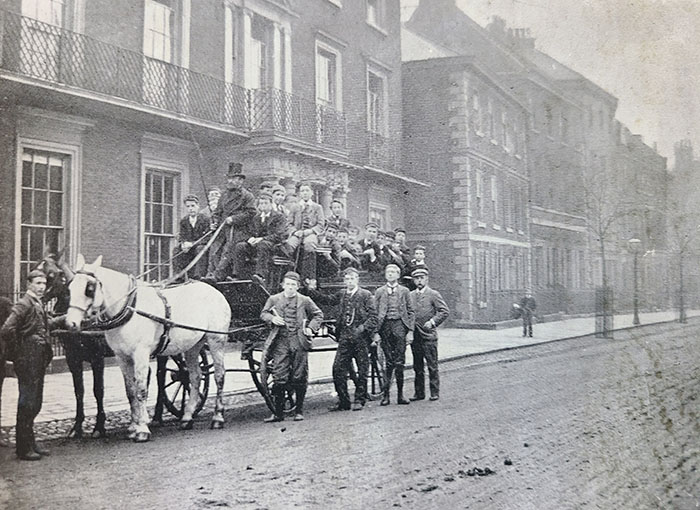 Early Photo of Bootham School Natural History Outing
Early Photo of Bootham School Natural History Outing
(Photo Credit: Bootham Bird List 1958)
The name Linnet comes from lin, meaning flax, and linum, Latin for feeding on flax seeds. Back in time, flax seed formed most of the birds’ diet. As well as widely distributed in the UK, Linnets are found across Europe and parts of Asia and Africa, and inhabit farmlands, scrubland, hedgerows, parks, and orchards. They were also introduced into the Dominican Republic.
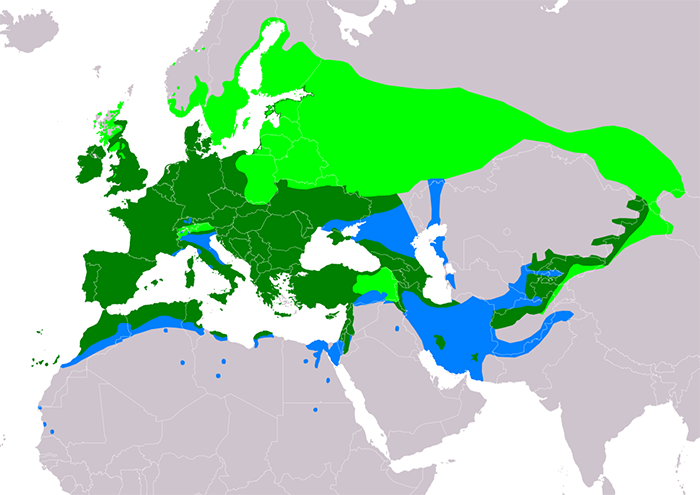 Linnet Distribution Map
Linnet Distribution Map
Light green: breeding; dark green: resident: blue: non-breeding.
(Photo credit: Wikipedia)
During the 1950s, these birds were reported around York year-round, they nested in the area, and were joined by large migrating flocks during winter. In the early 1960s, at Spurn Point, I observed several hundred migrating Linnets a day, and before dawn, you could hear them twittering high above in the dark, as they traveled along the coastline. They are one of the first species of bird to make it onto my Life List, along with other finch family members, such as the Chaffinch, Greenfinch, Bullfinch, and the winter visitor known as the Brambling. I describe the Chaffinch in Chapter 20 of my novel She Wore a Yellow Dress.
Because of their twittering, back in the 19th century, Linnets were a very popular cage bird.
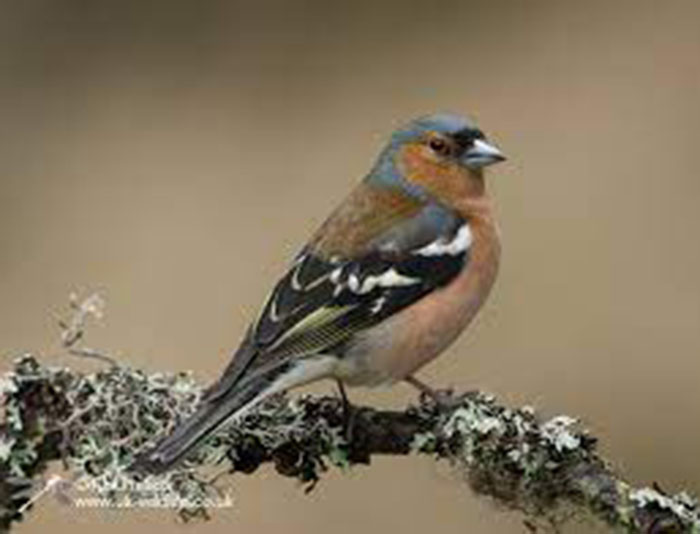 Chaffinch, Male
Chaffinch, Male
(Photo Credit: Kelvin Rumsby/Getty)
Male Linnets have grey heads, dark pink foreheads and breasts, and rich brown backs. Females are more modestly colored. They feed on the ground and in hedgerows, gorse thickets, heathland, and scrub, and consume mainly seeds. Their numbers have fallen. Between 1970 and 2014, the estimated decline in the UK was 54 percent, and across Europe, from 1980 to 2008, a 62 percent reduction is estimated. Changes in farm practices, removal of hedges, and the greater use of herbicides and fertilizers are causes of this decline.
Here in California, the most common species of bird that visits my birdfeeders is the House Finch. They are similar in size to Linnets (around 5.5 inches/14 cm long), and the males have red markings, comparable to the male Linnets. They are year-round residents, and nest in bushes, or in ivy on buildings, or holes and ledges on manmade structures, and occasionally use the abandoned nests of other birds. They are strongly attracted to bird feeders, preferring to eat small sunflower seeds. They also enjoy using bird baths.
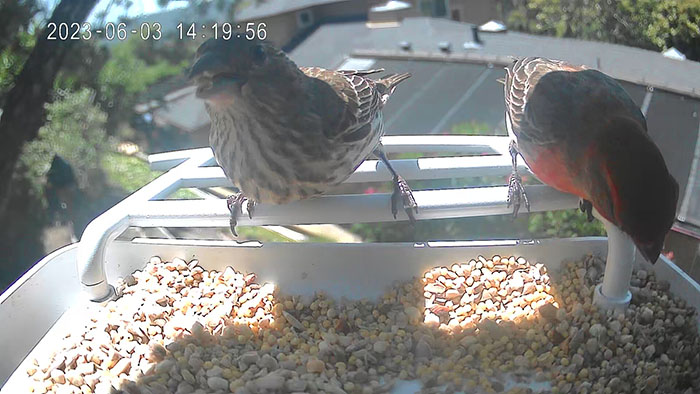 House Finches at Author’s Bird Feeder
House Finches at Author’s Bird Feeder
(Photo Credit: Author)
Of note, some of the male birds’ coloration comes from pigments in the berries and fruit that they eat. If present when molting, the pigment in their feathers will become a stronger red. This is important since females prefer to mate with the reddest of males they can find.
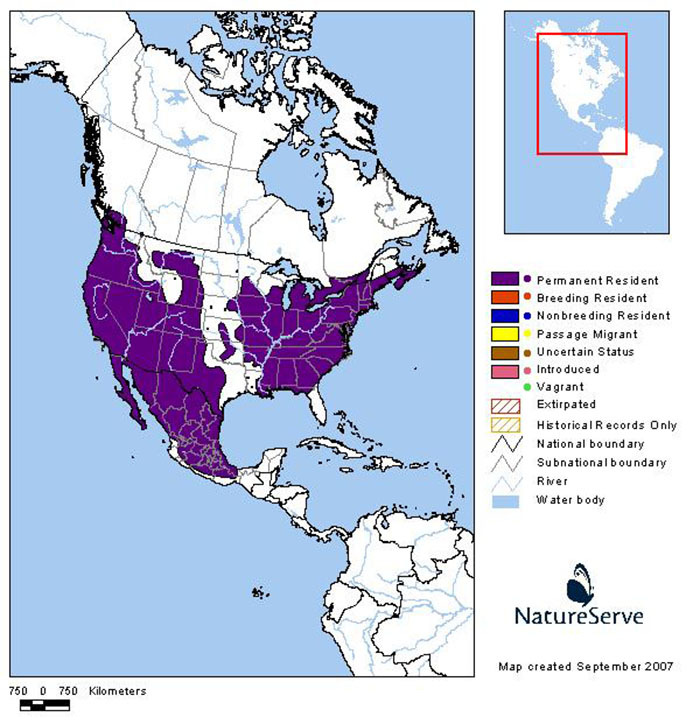 House Finch Distribution Map
House Finch Distribution Map
(Photo Credit: NatureServe)
House Finches are native to the southwestern United States and Mexico, with California as their capital, and they are mainly permanent residents. Today, an introduced population has established itself on the eastern side of the country. Many of these eastern birds migrate south for winter, with the females flying further south than the males. These birds originate from past practices when caged birds were transported to New York for sale as pets. In 1940, several Long Island shop-owners decided to release their birds to avoid prosecution for selling them. These few released birds multiplied during the following years, and the species’ current population, including those in the southwest, is estimated at between 250 million to over one billion. The species was also introduced in Hawaii around 1859.
Some Californians have suggested that the name House Finch should be changed to Linnet, or California Linnet, because of the bird’s similarity in appearance to the Eurasian Linnet, and the prestige that the new name would carry. So far the idea has not caught on. There is no close genetic relationship between the two species, and flax, after which the Linnet is named, is not a native plant to North America.
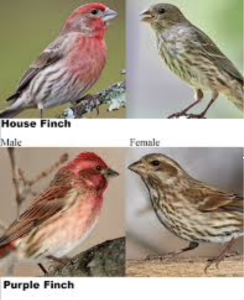 Comparison of Purple Finch with House Finch
Comparison of Purple Finch with House Finch
(Photo Credit: Chris Mart)
Before I end, I should mention the Purple Finch. This is a bird whose appearance is the most like the House Finch, especially the females, and it can be tricky distinguishing between the two. However, male Purple Finches are colored a deep cranberry or raspberry red, whereas male House Finches are more orangey- red. Additionally, the male House Finch has brown streaking under its wings, and the territory of the Purple Finch is mainly further north than the House Finch.
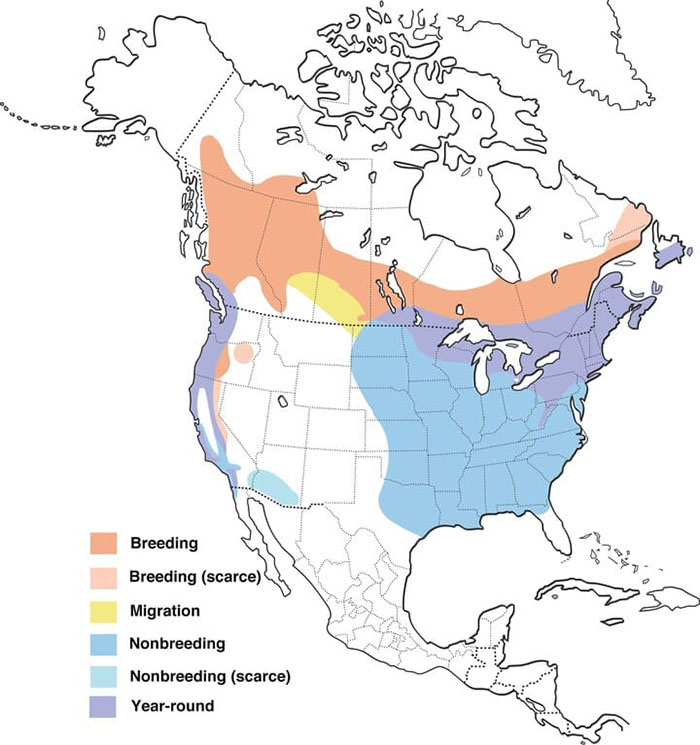 Purple Finch Distribution Map
Purple Finch Distribution Map
(Photo Credit: All About Birds, Cornell University)
In summary, if you are in California, go listen to the twittering of House Finches, as they hide among the branches for their turn to eat at the bird feeder. If you don’t have a bird feeder, possibly buy one? If you are in England, you probably will have to travel to the countryside to see the Linnet, since these birds have not yet been persuaded to use garden bird tables.



